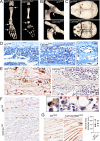CSF1R as a Therapeutic Target in Bone Diseases: Obvious but Not so Simple
- PMID: 36197652
- PMCID: PMC9718875
- DOI: 10.1007/s11914-022-00757-4
CSF1R as a Therapeutic Target in Bone Diseases: Obvious but Not so Simple
Abstract
Purpose of review: The purpose of the review is to summarize the expression and function of CSF1R and its ligands in bone homeostasis and constraints on therapeutic targeting of this axis.
Recent findings: Bone development and homeostasis depends upon interactions between mesenchymal cells and cells of the mononuclear phagocyte lineage (MPS), macrophages, and osteoclasts (OCL). The homeostatic interaction is mediated in part by the systemic and local production of growth factors, macrophage colony-stimulating factor (CSF1), and interleukin 34 (IL34) that interact with a receptor (CSF1R) expressed exclusively by MPS cells and their progenitors. Loss-of-function mutations in CSF1 or CSF1R lead to loss of OCL and macrophages and dysregulation of postnatal bone development. MPS cells continuously degrade CSF1R ligands via receptor-mediated endocytosis. As a consequence, any local or systemic increase or decrease in macrophage or OCL abundance is rapidly reversible. In principle, both CSF1R agonists and antagonists have potential in bone regenerative medicine but their evaluation in disease models and therapeutic application needs to carefully consider the intrinsic feedback control of MPS biology.
Keywords: CSF1R; Homeostasis; Macrophage; Osteoclast; Osteoporosis.
© 2022. The Author(s).
Conflict of interest statement
The authors have no existing conflicts of interest.
Figures



References
-
- Wiktor-Jedrzejczak W, Bartocci A, Ferrante AW, Jr, Ahmed-Ansari A, Sell KW, Pollard JW, Stanley ER. Total absence of colony-stimulating factor 1 in the macrophage-deficient osteopetrotic (op/op) mouse. Proc Natl Acad Sci U S A. 1990;87(12):4828–4832. doi: 10.1073/pnas.87.12.4828. - DOI - PMC - PubMed
-
- Van Wesenbeeck L, Odgren PR, MacKay CA, D’Angelo M, Safadi FF, Popoff SN, et al. The osteopetrotic mutation toothless (tl) is a loss-of-function frameshift mutation in the rat Csf1 gene: evidence of a crucial role for CSF-1 in osteoclastogenesis and endochondral ossification. Proc Natl Acad Sci U S A. 2002;99(22):14303–14308. doi: 10.1073/pnas.202332999. - DOI - PMC - PubMed
Publication types
MeSH terms
Substances
LinkOut - more resources
Full Text Sources
Medical
Research Materials
Miscellaneous

